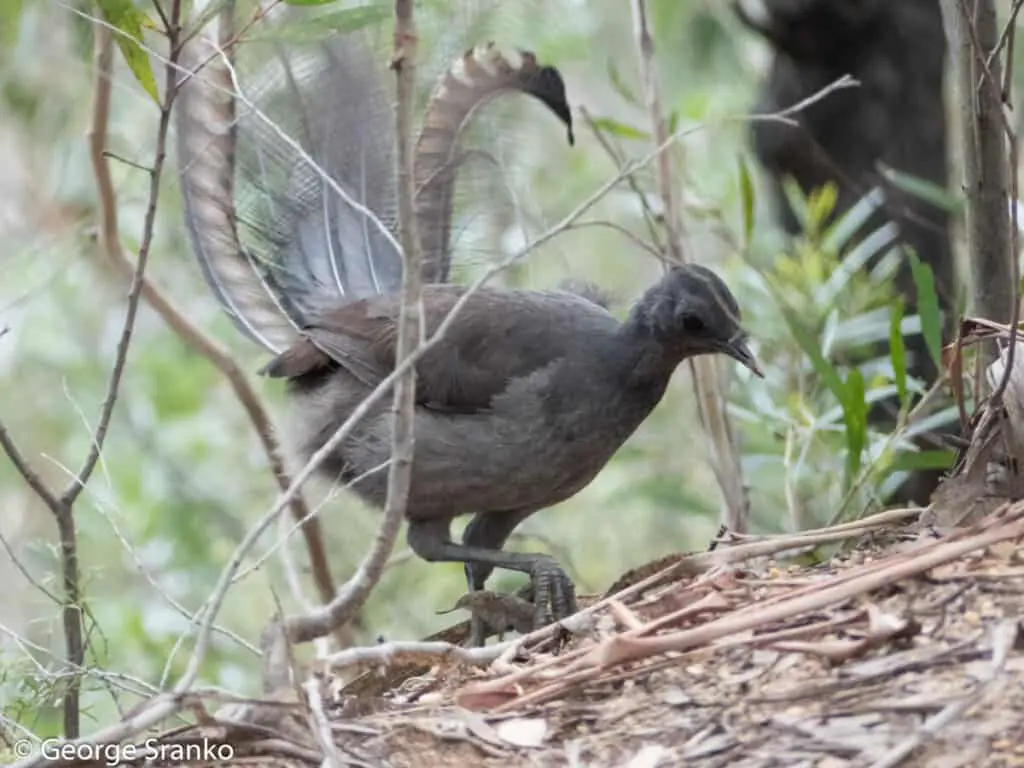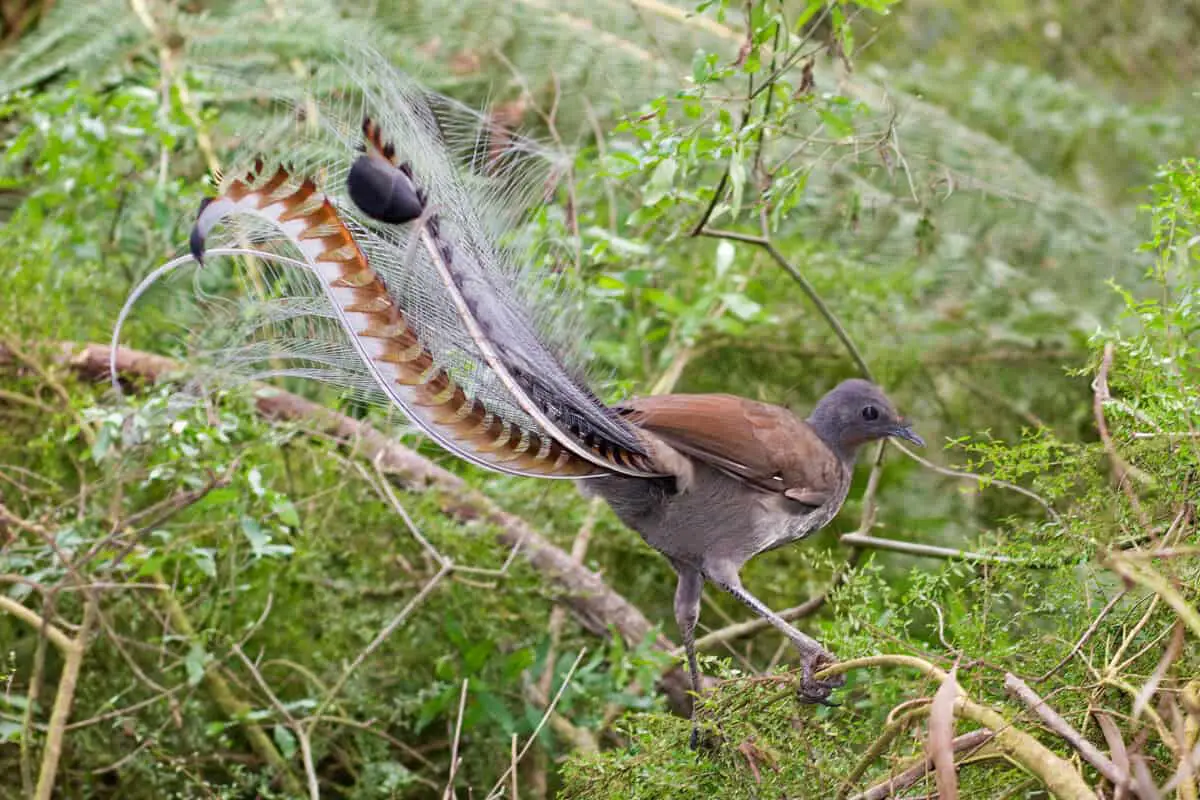Whenever we explore the scenic hills and valleys of eastern Australia we are on the lookout for the amazing Superb Lyrebird. The lyrebird has become somewhat of a movie star since David Attenborough featured one mimicking the sounds of a chainsaw on the BBC series Life of Birds (see the video at the end of this article).
Where can you see the superb lyrebird in the wild? The best place we’ve found for sighting lyrebirds in the wild is the world-renowned Blue Mountain National Park, within an easy 2-hour drive of cosmopolitan Sydney Australia.
Even though we are beginning birders, we succeeded in sighting lyrebirds on two separate occasions in their natural habitat. Both times we were on well-maintained foot paths only a few meters from the car park.
The superb lyrebird is one of the most spectacular of the Australian birds. Surprisingly, it is a songbird; one of the world’s largest. The lyrebird is renowned for its amazing ability to mimic any sound it hears, including the calls of other birds and human-created sounds such as musical instruments and construction tools. Although the intricate mimicking call is common throughout the lush rainforests and wet eucalypt woodlands in eastern NSW, the superb lyrebird is shy and does a good job of blending in with the bush.

How do you get to see a lyrebird?
When you first step into the eucalypt forest of the Blue Mountains it feels as if you’ve been transported to an ancient world of dinosaurs. In the shaded glens you will find giant tree ferns that can tower up to 10 meters and exotic-looking grass trees. Gum trees stand up to 30 meters tall and some of the trunks can be massive. The temperate eucalypt groves of the Blue Mountains provide the perfect habitat for superb lyrebirds.

The first time we spotted a lyrebird we were standing on a viewing platform overlooking the edge of the forest where the terrain dropped off steeply into the valley below. The sounds of birds filled the air and we stood quietly absorbing the beautiful view and the lovely scent of the eucalypts. Jan seemed absorbed in one of the songs and whispered to me that it sounded like a lyrebird. We were accustomed to the songs of the whip bird and the screeching patter of native parrots and lorikeets. To my ear there was nothing different about the bird songs all around me. But Jan was convinced that she had heard a lyrebird.
How did Jan recognize the call?
“As we were getting ready for a trip to Australia, my husband was preparing a talk on lyrebirds. Throughout the house came a melody of different bird songs combined with toy guns, car alarms and musical instruments and I would have a chuckle.
We arrived at a Blue Mountain trailhead for a walk just before sunset to stretch our legs. Then I heard the same Mixed-Up Melody of bird songs and quickly turned to look over the fence. I clearly saw a pheasant like bird walking along two metres below me trailing his long tail feathers behind. I called to George to hurry for a picture, but the bird hiked into the bushes and disappeared.”
After all our walks through the Australian bush we had finally encountered what had become a mythic creature for us – the superb lyrebird. It was just a quick sighting, but we were on cloud nine! I was so impressed that Jan had recognized the mimicking call!
The second time we spotted a lyrebird we were just returning from the spectacular Pulpit Rock Lookout and had almost reached the car park. We saw a movement in the bush and after careful maneuvering we spotted a brownish looking bird scratching at the leaf litter. It didn’t seem nervous even though it knew we were there. Australian Brush-turkeys are common in that area, but they are black and this one didn’t seem dark enough. Our bird continued to move along scratching at the leaves while looking for tasty grubs and insects. Then the tail came up and there was no mistaking the distinctive look of the lyre-shaped feathers.

Here was the chance of a lifetime to get a photo of the lyrebird in its natural habitat. I managed to get some shots – not great photos but good enough for record shots – and we continued to watch the lyrebird for several minutes before it moved off into the thick bush. This one didn’t sing for us, but we had an excellent look at it.
Wow! Two sightings in one visit to the Blue Mountains!
What sounds can the lyrebird mimic?
I don’t think there’s any limit to the sounds the lyrebird can make; chainsaws, car alarms, camera shutters, musical instruments, dog barks, human speech — you name it! Superb lyrebirds can accurately imitate an astonishing selection of sounds that they incorporate into their sexual displays.
According to Australian National University researchers Dalziell and Magrath (see reference below), lyrebird mimicry is so accurate that even the species being imitated rarely recognize the copies. Acoustic analyses show that imitations were almost indistinguishable from models. Male lyrebirds display perfect accuracy but tend to abridge the songs by reducing repetition of notes.
Why would male lyrebirds abridge or cut their mimicked songs short if they want to impress the females with their vocal prowess? The ANU researchers suggest that the females are looking for potential mates who have the most accurate mimicry. The male lyrebird with the largest repertoire of accurate sounds has the best chances of attracting a mate. What more incentive would they need to pack together as many perfect sounds as possible!?
This is what Jan picked-up on when she heard our first lyrebird sing – the male bird’s personally selected mash-up of abridged songs.
Accurate singing & perfect dancing… courtship can be demanding!
Not only is the female looking for accurate vocal mimicry, she is also searching for an outstanding dancer! The male must put on a spectacular courtship display if he has any hope of attracting a female.
Superb Lyrebirds breed from April to October. As soon as he spots a female, the male fans out his tail and vibrates the tail feathers, while beating his wings and strutting around one of his mounds of leaf litter. At the same time, he sings his impressive repertoire of highly practiced sounds, 80% of which are perfect mimicry. Turns out that the ‘dance choreography’ must also be perfectly coordinated with the song to attract a female.
If the male is successful, the female will mate with him. If not… well, it’s the age-old story!
Check out my in-depth article on why male birds have to work so hard to impress females: Why are Male Birds More Colorful? Ins and Outs of Sexual Selection.

Do lyrebirds build nests?
Female lyrebirds build large domed nests out of sticks on raised earth platforms, and seem to prefer wetter ground. They also prefer to nest deep in the thick bush were there’s plenty of leaf litter and overhead vegetation to conceal them from predators.
Females breed once per year and take on parental duties without any assistance from the male. The clutch usually consists of a single egg at a time.
Where are the Blue Mountains?
The Blue Mountains UNESCO World Heritage area is found in New South Wales, in south-east Australia. It was established in recognition of the exceptional ecological diversity of one of the largest and most intact tracts of protected bushland in Australia. The sandstone tablelands that make up the Blue Mountains feature breath-taking lookouts and waterfalls, historic walking tracks, and indigenous cultural sites. Being so close to Sydney, Australia’s largest city, makes it easy to access the 1.03 million hectares of protected eucalypt forest by road or by railway.

Katoomba is approximately 1.5 hour drive from downtown Sydney.
Unfortunately, 80% of this exceptional bushland was burned in the devastating bushfires of 2019-2020. Even though the eucalypt forest is resilient and well-adapted to fires, these fires verged on being catastrophic. Despite the devastation, within weeks of the fires, young plants were bursting through the blackened soil and some of the trees began showing new growth. It will take years before the forest is fully recovered, as seeds are spread from pockets of untouched bushland and new plants take hold.
Additional Interesting facts
- Until recently, it was commonly believed that female lyrebirds rarely vocalized since it was not part of their courtship ritual. Researchers are now discovering that females superb lyrebirds do, in fact, have complex songs that play a role in defending their nests and to mediate female-female competition for breeding territories.
- There is a second species of lyrebird found in Australia: Albert’s lyrebird, found on the eastern edge of the QLD/NSW border. Albert’s lyrebird doesn’t have the outer lyre-shaped tail feathers of the superb lyrebird, but it is capable of perfectly accurate mimicry.
Recognize this crest?

NSW National Parks and Wildlife Service
David Attenborough’s video of lyrebird mimicry
References
Fooling the experts: accurate vocal mimicry in the song of the superb lyrebird, Menura novaehollandiae. Anastasia H. Dalziell, Robert D. Magrath, 2012. Animal Behaviour, Volume 83, Issue 6, June 2012. https://doi.org/10.1016/j.anbehav.2012.03.009
Elaborate Mimetic Vocal Displays by Female Superb Lyrebirds. Anastasia H. Dalziell and Justin A. Welbergen, 2016. Front. Ecol. Evol., 20 April 2016.
https://doi.org/10.3389/fevo.2016.00034
Check Out Our TOP Articles for Even More Fascinating Creatures
- How do Octopus Reproduce? (Cannibalistic Sex, Detachable Penis)
- Do Jellyfish have Brains? How Can they Hunt without Brains?
- Why are Deep Sea Fish So Weird and Ugly? Warning: Scary Pictures!
- Are Komodo Dragons Dangerous? Where Can you See Them?
- Koala Brains – Why Being Dumb Can Be Smart (Natural Selection)
- Why do Lions Have Manes? (Do Dark Manes Mean More Sex?)
- How Do Lions Communicate? (Why Do Lions Roar?)
- How Dangerous are Stonefish? Can You Die if You Step on One?
- What Do Animals Do When They Hibernate? How do they Survive?
- Leaf Cutter Ants – Surprising Facts and Adaptations; Pictures and Videos
- Irukandji Jellyfish Facts and Adaptations; Can They Kill You? Are they spreading?
- How to See MORE Wildlife in the Amazon: 10 Practical Tips
- Is it Safe to go on Safari with Africa’s Top Predators and Most Dangerous Animals?
- What to Do if You Encounter a Bullet Ant? World’s Most Painful Stinging Insect!
- How Do Anglerfish Mate? Endless Sex or Die Trying!
- How Smart are Crocodiles? Can They Cooperate, Communicate…Use Tools?
- How Can We Save Our Oceans? With Marine Sanctuaries!
- Why Are Male Birds More Colorful? Ins and Outs of Sexual Selection Made Easy!
- Why is the Cassowary the Most Dangerous Bird in the World? 10 Facts
- How Do African Elephants Create Their Own Habitat?
- What is Killing Our Resident Orcas? Endangered Killer Whales
- Why are Animals of the Galapagos Islands Unique?
- Where Can You See Wild Lemurs in Madagascar? One of the Best Places
- Where Can You see Lyrebirds in the Wild? the Blue Mountains, Australia
- Keeping Mason Bees as Pets
- Why do Flamingos have Bent Beaks and Feed Upside Down?
- Why are Hippos Dangerous? Why Do They Kill People?


